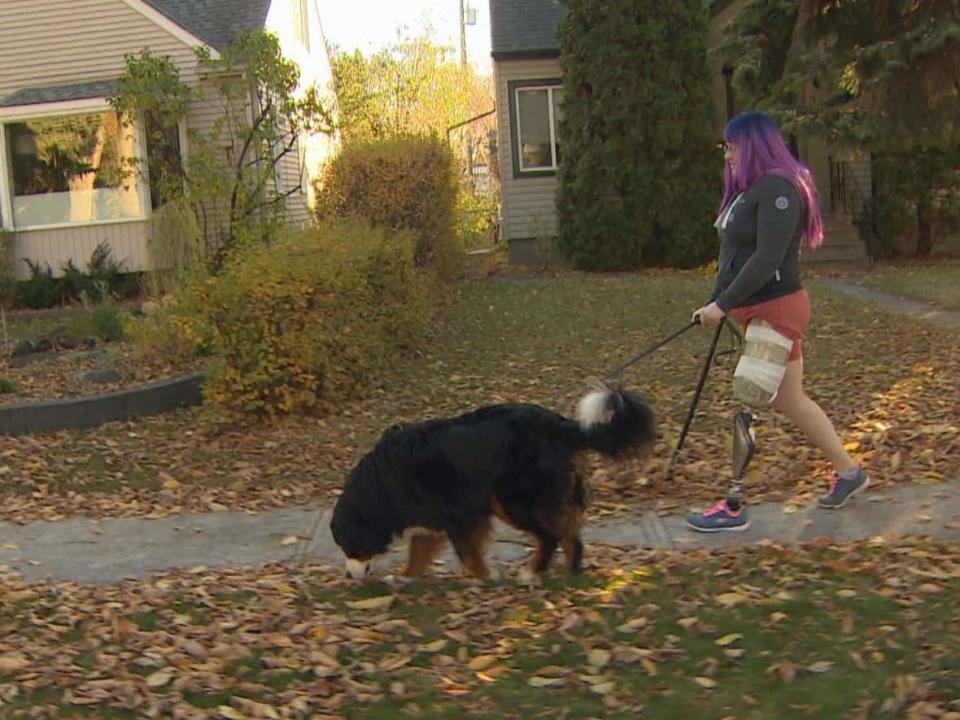Alberta's prosthetic funding model is outdated and unfair, amputees say

After months in a wheelchair, Angela Oakley is walking again, slowly descending the front steps of her parents' house in Edmonton's Highlands neighbourhood as she makes her way to a physiotherapy appointment at the Glenrose Rehabilitation Hospital.
Oakley, a veterinarian who lives in Grande Prairie, Alta., started battling a bone infection in her left leg when she was in vet school in 2010. After scores of surgeries and having part of her leg amputated a few years ago, she became an above-knee amputee in March.
Last week, after months of complications and pandemic-related delays, she finally received a new prosthetic knee that should allow her to walk, cross-country ski and ride horses again. A longtime multi-sport athlete, she also has dreams of representing Canada at the Paralympic Games.
Her mobility, however, comes at a high price. Her new knee costs about $57,000 and Alberta Aids to Daily Living, the provincial program that funds medical equipment for long-term disabilities, will pay no more than $6,000.
If she lived in England, her prosthetic limb would be fully covered. But in Alberta and other Canadian provinces, amputees are responsible for paying most of the cost.
"How many Albertans can turn around and drop $50,000 on a knee?" Oakley said during an interview with CBC News last week.
Oakley, who launched a petition advocating for prosthetic funding changes and contacted Alberta's health minister, believes the current funding structure is outdated and unfair, preventing amputees who cannot afford limbs they need from doing activities they love and fully contributing to their communities.
In a country known for its universal health care system, "we're letting all of these people down," she said.
Why are some knees so expensive?
There are generally two types of prosthetic knees: mechanical and microprocessor.
A mechanical knee replaces the knee joint with a mechanical hinge, but a microprocessor — also known as "computerized" — knee is much more sophisticated — and expensive.
With a computer and sensors, a microprocessor knee automatically adapts to real-time information about the user's gait and walking speed.
"How many Albertans can turn around and drop $50,000 on a knee?" - Angela Oakley
For some amputees, a cheaper mechanical knee is sufficient, but not for Oakley, who is highly active with a physically demanding job. She also felt unsafe using a mechanical knee because of the nerve damage and lack of muscle strength in her left leg.
"I didn't have the quadriceps strength to swing it through and lock it," she said. "When I would step, the knee wouldn't be locked, so it would just collapse out from under me."
Oakley was shocked to learn that microprocessor knees cost from $35,000 to $95,000, and that the most she would receive from Alberta Health is a $6,000 grant covering about 10 per cent of the cost.
Watch | Amputees call for prosthetic funding changes:
As a below-knee amputee, she only paid a $500 deductible for prosthetic components.
Friends, family and colleagues helped her raise money through a crowdfunding campaign and other online fundraisers, but she was only able to pay for the microprocessor knee thanks to her employer contributing the rest.
Her new knee won't last forever either. Oakley, 32, expects she will need five to eight replacements over her lifetime, as prosthetic knees usually last six to 10 years.
Oakley managed to pay for her knee, but amputees who cannot afford them often end up using prosthetics that are less suited to their bodies, she said.

Years of advocacy, no results
Ben Proulx, who lost one of his legs to cancer when he was four years old, received his first microprocessor knee when he was a teenager.
Like Oakley, he struggled to use a mechanical knee, experiencing back problems and hip pain.
His current knee, which he paid for with crowdfunding proceeds and funds from the War Amps, has allowed him to coach youth sports and hike with his family without pain.
"It allows me to have a more normal lifestyle and it takes less of a toll on my body," Proulx said.
He has advocated for more prosthetic funding from the last three provincial governments without success.
Proulx's prosthetist has accompanied him to meetings with policymakers, armed with studies and data showing long-term cost savings associated with funding microprocessor knees, but he said the conversations still "go nowhere."
"It would actually be a minimal spend for the government to up their game and take care of Albertans who have a prosthetic leg and fund it properly up front. But they're not likely to gain any votes from it because there are not that many of us."
His current knee, which cost $40,000, will likely need to be replaced in four or five years and Proulx worries about how he will pay for a new one.
"It gets very demoralizing over time wondering, 'Hey, where's my next body part going to come from?' when that's really not something that you should have to worry about," he said.
Alberta Health spokesperson Carolyn Gregson said the Alberta Aids to Daily Living program "is intended to meet basic needs to help Albertans remain independent."
Gregson said the program provided grants for microprocessors to eight Albertans in the 2020–21 fiscal year.

'We need to increase coverage'
In an article for the Canadian Prosthetics & Orthotics Journal, Calvin Howard and his colleagues reviewed prosthetic coverage in all 10 provinces, finding variable funding levels.
They discovered amputees could receive up to $15,000 for microprocessor knees in Saskatchewan and up to $20,000 in New Brunswick. Nova Scotia's coverage was similar to Alberta's. No provinces fully funded them.
Howard, who is now a doctor in Manitoba, said the cost of prosthetics has exploded in recent years but provincial policies have not caught up.
"We need to increase coverage if we're really going to be able to provide for amputees," he said.
Though advanced prosthetics are expensive up-front, he said, research has shown that high-quality prosthetics can lead to societal cost-savings over time.
Someone using a microprocessor knee for a decade, for example, will put less strain on their hip, reducing their likelihood of needing a total hip replacement than if they had used a "minimally functional prosthetic device," he said.

 Yahoo Movies
Yahoo Movies 